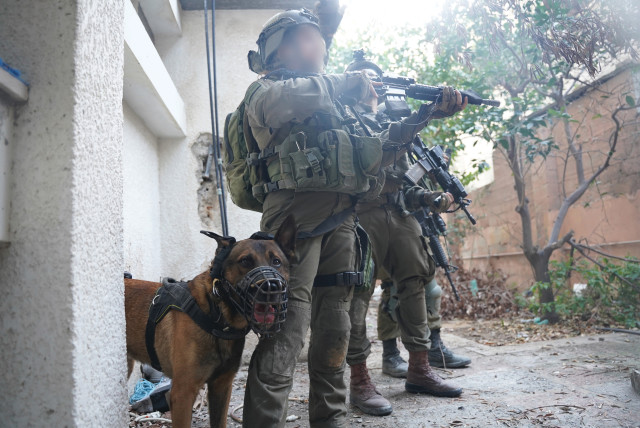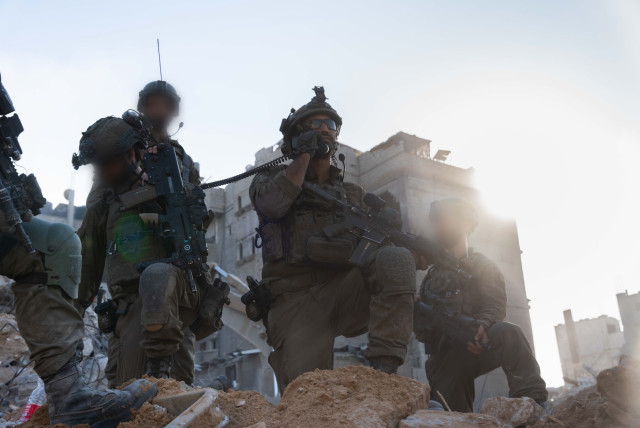How does the IDF dismantle Hamas strongholds in Rafah?

The IDF Southern Command is writing a new combat doctrine, which, for the first time ever, combines combat above and below ground at the same time.
The Givati patrol quickly surrounded a dense group of buildings deep in Rafah and surprised terrorists in the area. Some of them were killed in an exchange of fire when they went out to launch anti-tank missiles; others went down into the tunnels or fled north towards Khan Yunis.
A Walla reporter accompanied Israeli forces and documented the Israeli forces' operations.
A vigilant team detected suspicious movements in the mosque area. After checks with the intelligence officials in the field, it was decided to close all the streets around the mosque and to send "Sam," the attack dog of the Oketz Unit.
Sam smelled the courtyard of the mosque, entered independently into one of the spaces in the building, scanned it, heard noises, and navigated down through a hidden staircase that led him to the terrorists from the Nukhba special forces of Hamas. An armed terrorist was hiding on the side of the narrow building, and only an iron net separated them. Sam, at this point, acted completely independently, located another small opening, entered the room, jumped at one of the terrorists, and bit him hard.
It was one dog against seven terrified terrorists who ran to grab weapons. Sam was sharp and attacked several terrorists one after the other. In the background, you could hear the terrorists' screams of pain and cries for help. One of the terrorists shot at him but didn't. Sam was "locked" by biting the hand of one of the terrorists who was holding a weapon. Finally, another terrorist shot Sam at short range and overpowered him.

Later, the Givati Brigade Col. Liron Batito said that the terrorists were surprised twice "by Givati Patrol soldiers who quickly arrived at the heart of the neighborhood in Rafah, and once again by the dog of the Oketz Unit that found the way to reach them underground. Unfortunately, the dog is dead."
The soldiers of the Givati Patrol and the Yalam Unit searched the building a few hours later and discovered "Sam's" body, unloaded the camera from his body, recovered the documentation, and discovered, to their astonishment, the battle that took place deep in the ground against the terrorists.
"There was no way that the terrorists could be located without the dog's precise scans," explained Batito. "The camera footage revealed the hidden shaft from which they escaped, and then it turned out that it's a significant underground route with many branches in Rafah."
Continuing to dismantle Hamas infrastructure
Walla also accompanied the Givati Brigade, who are leading the task of dismantling Hamas infrastructure on the Egyptian border, as well as in what is considered one of the most dangerous neighborhoods in Rafah - Tel Sultan.
Despite the long preparation of Hamas's Rafah Brigade for the IDF's ground maneuver and the many traps set in residential houses, Givati soldiers managed to surprise the terrorists upon approach.
One day, the Shin Bet identified terrorists in the area of a warehouse on which the United Nations inscription was emblazoned; they contacted the terrorists and offered them to surrender or fight, then finally using drones that were activated above their heads as they were "acquitted" (they stripped off their clothes to see that they were not carrying weapons and explosive devices).
"The use of human shields for terrorists in clinics, hospitals, UN warehouses, and schools is a recurring motif throughout the war, and it is still the most complex distance of an underground route I have come across," a Givati official said.

The IDF Southern Command told Walla that the divisional combat team under Col. Batito's command is writing a new combat doctrine. For the first time, combat above and below ground is combined to push the enemy out of the area of operational control.
The divisional intelligence officer is holding a map of one of the neighborhoods on which all the contours in the area have been marked with red lines.
"This is the work of ants. In some cases, we knew about them before the ground incursion. In some cases, it was found in the field through scans, from terrorist investigations, and some were discovered through the investigation of the electronic equipment or documents," Batito explained and emphasized that this is a map that is updated daily.

"They dug tunnels here at a depth of 27 meters. More than twenty tunnels were dug adjacent to the Philadelphi corridor. We have already destroyed some of them, and some are being tested now. The scanning and drilling operations are still ongoing to locate more tunnels. It's a big challenge, so it takes time. But we will dismantle what Hamas has built here for more than 20 years.
"My mission is simple. Make sure that there are no tunnels crossing from Rafah to Egypt. You understand the consequences of this. Cut off Hamas from its source of power - it's more than smuggling; it's a lot of money. According to my estimate, 80% of the tunnels are already in our hands."
Col. Batito explained what the fighting routine looks like in the Rafah region, saying, "Some of the terrorists fled from Gaza and Khan Yunis came here. This required us to be very creative. I estimate that within a month, we will annihilate all the Hamas battalions in Rafah. And if they decide to flee again? We will destroy all the infrastructure they built. Weapons production infrastructure and such.
"So far, the IDF has killed 17 thousand terrorists. In Rafah, the 162nd Division killed about 550 terrorists. This week, we killed four in the Shabora neighborhood."
Hamas terrorists work systematically not to go out into the streets and be exposed to Givati fighters, and for this purpose, they break walls inside and between houses using hammers to jump from place to place.
"In one of the most unusual places, Givati soldiers uncovered an underground route under a cemetery in Rafah, where the terrorists connected several large burial chambers into one room, from which they dug a shaft where three Nohkba terrorists and a commander were hiding, who were arrested and taken for questioning."
Walla reported that at one point, Batito clenched his hands and punched the palm of his hand to emphasize his words. He describes how the Givati Brigade also pays a heavy price in combat.
"On June 10, activity in the Shabora neighborhood involving the 9th Battalion unfolded, and a commander and soldier entered a building that didn't look suspicious, but it turned out to be a trap. After a bomb was thrown at him and nothing happened, an explosion apparently initiated by the terrorists from a distance occurred. As a result of the explosion, four fighters were killed and wounded six more, and later, one of the soldiers who was seriously wounded died of his wounds while in the hospital."
